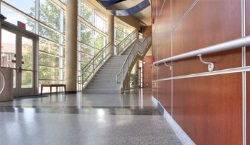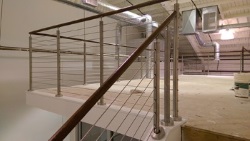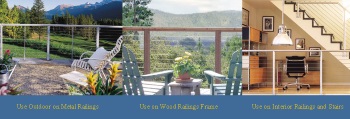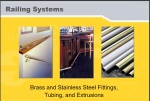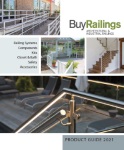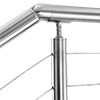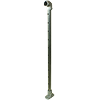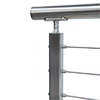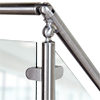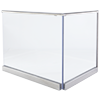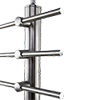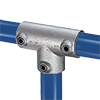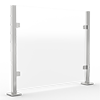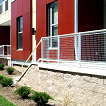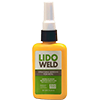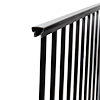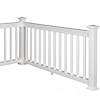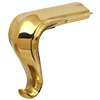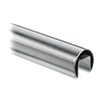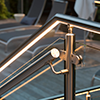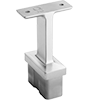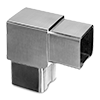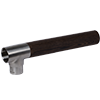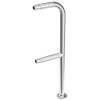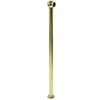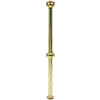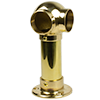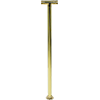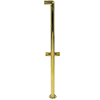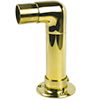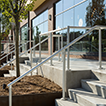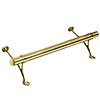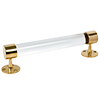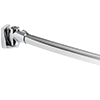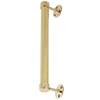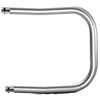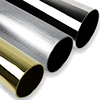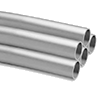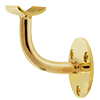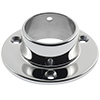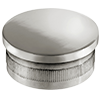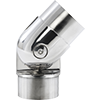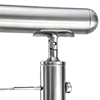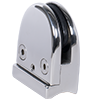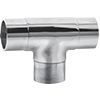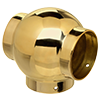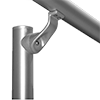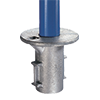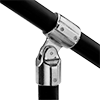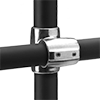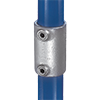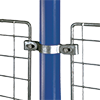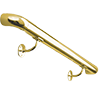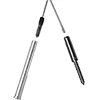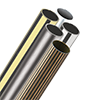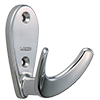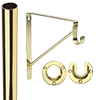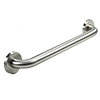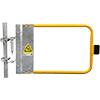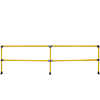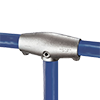Frequently Asked Questions
Railing Systems - FAQ
| Q: Do you offer custom bending? |
| A: All our tubes are bendable, but currently we do not offer custom bending service.. |
| Q: What size tubing do you recommend for a handrail? |
| A: We recommend 1-1/2" OD (outside diameter) tubing as a handrail. Note: Please check your local building code. |
| Q: What size tubing do you recommend for a footrail? |
| A: We recommend 2" OD (outside diameter) tubing for a foot rail. |
| Q: Can the Hollaender aluminum fittings be used with steel and stainless steel pipe? |
| A: Although most aluminum alloys will corrode when combined with a dissimilar metal (i.e. steel, black iron, stainless steel), the aluminum/magnesium alloy 535 which Hollaender uses to manufacture all cast fittings is the most corrosive resistant casting alloy available and can be used with any type of metal. |
| Q: Have Hollaender Fittings been tested in corrosive environments? |
| A: Yes, Hollaender standard fittings have been tested for 1000 hrs. of salt spray (per ASTM B117 specifications) after which the set screws could still be removed and retightened. In addition, Hollaender fittings' corrosion resistance to Hydrazine Fuel has also been tested by the United States Air Force prior to the products' use at Cape Canaveral Air Force Station and the Kennedy Space Center. Not only have our products been tested in the laboratory, but they have also stood the test of time for over forty years in some of the most corrosive environments including: chemical plants, offshore oil rigs, waste water treatment plants, pulp & paper mills, etc. |
| Q: Will Hollaender Speed-Rail® fittings suffer any galvanic reaction when in contact with galvanized steel? |
| A: Hollaender’s Speed-Rail® fittings are manufactured from 535 aluminum-magnesium alloy, this alloy will NOT suffer any galvanic or dissimilar metals corrosion when in contact with steel or galvanized steel. Galvanic reactions are caused by the dissimilarity in potential between two metals that causes electron flow between them. The farther apart in potential or nobility, the greater the reaction. Galvanized steel is immediately between magnesium on one hand, and aluminum on the other hand, on the galvanic scale in terms of potential. ALMAG fittings will not have a galvanic reaction with galvanized steel. Hollaender supports this with a 10 year non–corrosion warranty for the solar industry that covers all kinds of corrosion, including galvanic. |
| Q: Should the fittings be used in a chlorine rich environment? |
| A: No, the chlorine aggressively attacks the aluminum, which can result in significant deterioration of our product. Our recommendation would be to use reinforced fiberglass railing in this environment. |
| Q: What does IPS mean? |
| A: IPS stands for "Iron Pipe Size" - A standard which was originally developed for fluid transfer has also become the standard for handrail systems, both steel, and aluminum. |
| Q: What determines the wall thickness of my pipe? |
| A: One of two terms will tell you the wall thickness of your pipe, either the "Schedule" or "Gauge." If you are using true IPS sizes, the wall thickness is determined by the schedule - the higher the schedule, the thicker the wall, i.e. 1-1/2" schedule 80 has a thicker wall than 1-1/2" schedule 40. For gauge sizes, the lower the number, the thicker the wall, i.e. 1.90" diameter 11 gauge is thicker than 1.90" diameter 12 gauge. |
| Q: What wall thickness should be used with Hollaender fittings? |
| A: The actual wall thickness you select will depend on the type of system you are assembling, however, the wall thickness should never be less than the minimums listed below. Steel Pipe - Schedule 10 or 14 Gauge Aluminum - Schedule 40 or 10 Gauge |
| Q: What pipe materials can I use with Hollaender fittings? |
| A: Any metal pipe (including galvanized steel, stainless, black iron, aluminum, etc.) can be used with our slip-on fittings as long as it is sized properly (see above). Plastic, FRP and thin wall sleaving should never be used unless a reinforcing dowel is also used inside the pipe. |
| Q: If I have an extremely corrosive environment, are there any additional coatings or features that are available for the fittings to insure that the installation performs and continues to look good for a long time? |
| A: The standard material is highly corrosive resistant, however, for the most extreme environments, we recommend that the fittings be anodized and that stainless steel set screws be used. The anodizing process creates a coating, which is not only harder and more corrosive resistant than the base metal, but also provides significant resistance to staining. |
| Q: Will brass tarnish over time? |
| A: Yes, un-coated polished brass will tarnish over time. Regular maintenance with a brass polish will keep the finish close to the original polished finish. |
| Q: Do you offer custom cutting of tubes and pipes? |
| A: We offer cutting services in order to best meet your needs. No production run is too large or too small for us! Please note that special tubing cuts are not returnable and not refundable. Please include your cutting instructions in the comments section while submitting your order online. |
| Q: What is the difference between pipe and tube? |
| A: The primary difference between pipe and tubing is how the size is designated. Pipe is designated by a "Nominal Pipe Size" based upon the ID (inside diameter) of the most common wall thickness. Tubing is designated by the measured OD (outside diameter). For Example: A 3/4 inch iron pipe has an OD of 1.050 inches, while a 3/4 inch steel tube has an OD of 0.75 inches. |
| Q: What can I use to connect tubing? |
| A: To connect tubing, you will use an internal splice. Item# 830 |
| Q: How do you mount the tubing to the bracket? Do you have to drill holes in the tubing? |
| A: We recommend pre-drilling the hole and tapping the hole for a better installation. |
| Q: Do you have a handrailing bracket that allows the handrailing to fold down when not being used? |
| A: Unfortunately, we don't have any brackets like that. |
| Q: On a railing how many inches from the ends do you place the brackets? |
| A: You can place your first bracket 3-6" from the end. We recommend a bracket every 3-4 feet after that. |
| Q: Why is shipping/handling for tubes over 8-foot long cost $149? |
| A: UPS/FedEx do not accept shipment longer than 8 foot long. Therefore we must build a crate and ship them to you by truck/common freight carriers. To reduce shipping charges, you may consider buying tubes up to 8 feet long and use a connecting splice. Click here to view the splice. |
| Q: Do your coated brass railings and brackets always take 12 to 14 business days before shipping? |
| A: We do have some that are pre-coated in advance, but if we are out of stock it takes about 13 business day lead time to get them clear coated. |
| Q: Do you have stores/showrooms around the country, if so where are they located? |
| A: We only have one showroom. It is located at 71 Commerce Drive, Brookfield CT 06804 |
| Q: What finishes do you offer for handrails/footrails? |
| A: You can choose from polished brass, polished stainless steel, or satin-brushed stainless steel (304 and 316). |
| Q: Do you offer any contractor discounts? |
| A: Yes, if you are a contractor we offer a 5% discount for orders over $500 before shipping and a 7% discount for orders over $1000 before shipping. You will need to call us and submit your company info to us. |
| Q: Do you ship overseas? |
| A: Yes we ship throughout the world. |
| Q: How do I go about a return/exchange? |
| A: We will issue you an RMA(Return Merchandise Authorization) and give you a confirmation number. Once that is done you will write the confirmation number on the box and send it back to us. When the returned item is received we will credit your payment back to you with a 20% restocking fee. |
| Q: Is there an adhesive for stainless steel connections? |
| A: Yes, the Lido- weld adhesive item LB-00201 indicates it is for brass but is also used for stainless steel. |
| Q: Do you offer wood handrails? |
| A: Yes, we offer handrails made out of Oak Wood. |
| Q: Can I pay by check? How long will it take before you can ship my order? |
| A: Yes you can pay with a personal or company check. It will take about 7 to 10 business days to clear before we can ship your order. If you pay by bank check/cashier check it will take about 3 business days. |
| Q: Is your brass tubing solid brass or plated in brass? |
| A: All our brass tubing and brackets are solid brass. |
| Q: What sizes do you carry in railings? |
| A: Our standard sizes for railings (eg for architectural railings) are 1 inch, 1-1/2 inch, 2 inch. For closet rods, our size comes in 1-5/16 inch and 1-1/16 inch For kitchen and curtain rods our size come in 5/8 inch or 1 inch |
| Q: How much do you charge for shipping? |
| A: We do not have flat shipping rates. However, when you place items into your shopping cart there will be an input box where you can enter your zip code and it will calculate shipping for you. |
| Q: How long does it take for grab bars to ship out? |
| A: All Grab Bars are custom made so it will take about 3 to 4 weeks lead time before they ship out. |
| Q: Where can I get prices for your products? |
| A: All our prices are listed on our website. Just click on the picture of the item and the price will be listed. |
| Q: What finishes match satin nickel and polished chrome? |
| A: Satin brushed stainless steel will match satin nickel and polished stainless steel will match polished chrome. |
| Q: What is the best way to connect end caps to tubing? |
| A: The best way to connect end caps to tubing would be our Lido-weld adhesive. |
| Q: Can I cut stainless steel tubing myself? If so what should I use? |
| A: Yes, to cut the tubing on your own we recommend a fine-tooth hack saw with at least 24 teeth per edge or a reciprocating saw with a fine-tooth blade. We also offer custom cutting for a fee. |
| Q: Do you carry antique brass? If not what type of brass do you carry? |
| A: We do not carry antique brass. We carry polished brass and polished brass clear coat (clear coat requires 12-14 days lead time). |
| Q: Do you have a printed catalog? |
| A: We do not have a printed catalog our website and prices are constantly updated. |
| Q: Does your handrail meet the 2006 IBC load criteria of 200 lbs? |
| A: Yes, as long as you use a support bracket every 4 feet. The 2006 IBCi Section 1607.7 describes Loads on handrails, guards, grab bars and vehicle barriers as follows: According to Section 1607.7.1 Handrails and guards, “Handrail assemblies and guards shall be designed to resist a load of 50 plf (0.73kN/m) applied in any direction at the top and to transfer this load through the supports to the structure.” The IRC also prescribes that only the single concentrated load as required by Section 1607.7.1.1 shall be applied. According to Section 1607.7.1.1 Concentrated load, “Handrail assemblies and guards shall be able to resist a single concentrated load of 200 pounds (0.89 kN), applied in any direction at any point along the top, and have attachment devices and supporting structure to transfer this loading to appropriate structural elements of the building.” |
| Q: What gauge of stainless steel is used for your grab bars? |
| A: Our grab bars, which are ADA approved, are 18 gauge, 049" |
| Q: How to Install Lido Plastic Closet Plastic System? |
A: 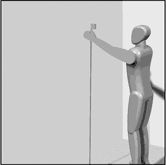 |
| Q: How to Install CableRail? |
A: 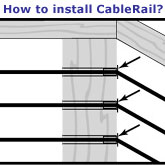 |
| Q: Solution Gallery Pictures? |
A: 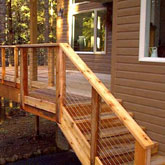 |
| Q: How to install Hollaender ADA Handrail? |
| A: Download Hollaender ADA Installation in PDF |
| Q: What is the alloy content of the solid brass tubing? |
| A: Our welded solid brass (not plated), mirror finish tubing (Alloy 268 for our 1.5” and 2”) is 66% copper & 34% zinc. |
| Q: What is the alloy content of the solid brass fittings? |
| A: For our solid brass fittings (brass casting), the alloy makeup is close to 59% copper, 41% zinc, with a low percentage of aluminum. |



